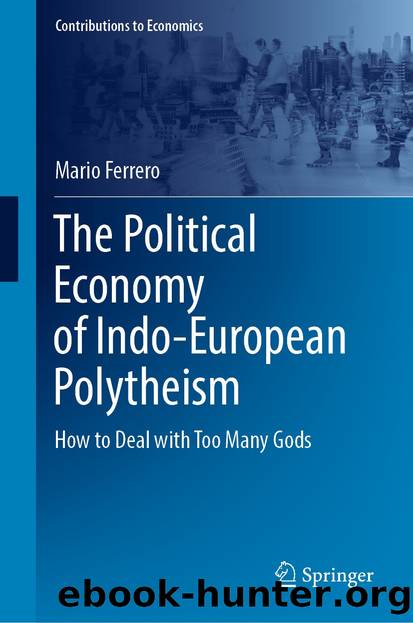The Political Economy of Indo-European Polytheism by Mario Ferrero

Author:Mario Ferrero
Language: eng
Format: epub
ISBN: 9783030979430
Publisher: Springer International Publishing
6.1.2 The Priests and Their Competition
We have seen that a key factor in the theological shift away from the Vedic pantheon was the need for the Brahmins to assimilate or subsume a variety of local, indigenous, often non-Aryan deities that the Vedic Aryans encountered in the long centuries of their expansion eastward and southward.3 Apparently these deities and their cult did not sit easily with the Vedic gods and their rituals, so through a process that spanned many centuries the latter were eventually replaced by the gods and rituals of the Puranic sects. Another key factor, however, was that from the fifth century BCE the Brahmins encountered a stiff competition in the form of self-consciously non-Brahmanical shramana (ascetic) religions, founded by renunciate teachers such as the Jina Mahavira and the Buddha and spread by their Jain and Buddhist monastic disciples (as well as by a long since extinct group, the Ajivikas).
These groups originated in the territory of the later kingdom of Magadha, in the lower Ganges plains, whereas the established Brahminsâ territory was to the west of it, in the upper Ganges valley. Magadha was the site of the urbanization process that took place before and after the middle of the first millennium BCE, a process which displaced the Brahmins who were a mainly rural institution servicing the small kingdoms or chiefdoms of the previous age. The new cities were cradles of social diversification and places of circulation and exchange of ideas and goods, and the Brahmins were ill-suited to this environment and tried to ignore it. In contrast, the ascetic groups found their audience and source of recruitment there. They were the carriers of the belief in karmic retribution, reincarnation, and release, which had originated outside Brahmanism, probably in Magadha, and they spread through the promotion of a route of escape from this cycle of rebirth: renunciation, which included nonviolence, vegetarianism, and general rejection of bodily pleasures in the pursuit of ascetical discipline and/or meditation and spiritual elevation. These ascetic orders were at first wandering mendicants; over time, they established monastic communities. As we have seen, with the late-Vedic Upanishads the Brahmins began to answer these concerns with their own theology of renunciation, but the question remained of how renunciation and married life in the world could coexist. The shramanas had clear, antagonistic answers: they targeted caste exclusions, scorned the Vedic gods, abhorred animal sacrifice, rejected the Vedas and Brahmanical authority, focused on the quest for liberation from samsara, and embraced monastic celibacy. If they wanted to survive as a priestly class, the Brahmins needed a response to that.
Yet another source of disadvantage for the Brahmins was the rise of the first pan-Indian state, the Maurya Empire (ca. 320â180 BCE), which wiped out and absorbed the petty kingdoms that used to be the customers of the shrauta rituals. The Mauryas were generally supporters of the shramana orders, and in particular the third ruler of the dynasty, the emperor Ashoka, was a devout Buddhist, even though he and his predecessors and successors paid respect to the Brahmins too.
Download
This site does not store any files on its server. We only index and link to content provided by other sites. Please contact the content providers to delete copyright contents if any and email us, we'll remove relevant links or contents immediately.
4 3 2 1: A Novel by Paul Auster(11788)
The handmaid's tale by Margaret Atwood(7447)
Giovanni's Room by James Baldwin(6808)
Asking the Right Questions: A Guide to Critical Thinking by M. Neil Browne & Stuart M. Keeley(5355)
Big Magic: Creative Living Beyond Fear by Elizabeth Gilbert(5351)
Ego Is the Enemy by Ryan Holiday(4956)
On Writing A Memoir of the Craft by Stephen King(4662)
The Body: A Guide for Occupants by Bill Bryson(4583)
Ken Follett - World without end by Ken Follett(4443)
Bluets by Maggie Nelson(4261)
Adulting by Kelly Williams Brown(4232)
Eat That Frog! by Brian Tracy(4149)
Guilty Pleasures by Laurell K Hamilton(4116)
White Noise - A Novel by Don DeLillo(3829)
The Poetry of Pablo Neruda by Pablo Neruda(3814)
Fingerprints of the Gods by Graham Hancock(3738)
Alive: The Story of the Andes Survivors by Piers Paul Read(3730)
The Book of Joy by Dalai Lama(3697)
The Bookshop by Penelope Fitzgerald(3619)
